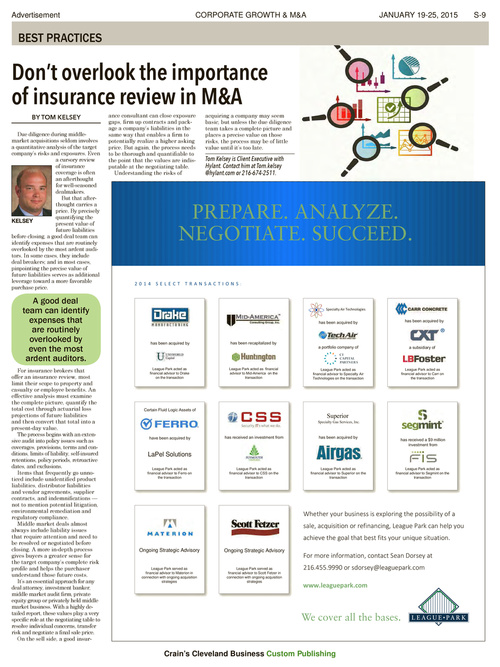- Page 1
- Page 2
- Page 3
- Page 4
- Page 5
- Page 6
- Page 7
- Page 8
- Page 9
- Page 10
- Page 11
- Page 12
- Page 13
- Page 14
- Page 15
- Page 16
- Page 17
- Page 18
- Page 19
- Page 20
- Page 21
- Page 22
- Page 23
- Page 24
- Page 25
- Page 26
- Page 27
- Page 28
- Flash version
© UniFlip.com
- Page 2
- Page 3
- Page 4
- Page 5
- Page 6
- Page 7
- Page 8
- Page 9
- Page 10
- Page 11
- Page 12
- Page 13
- Page 14
- Page 15
- Page 16
- Page 17
- Page 18
- Page 19
- Page 20
- Page 21
- Page 22
- Page 23
- Page 24
- Page 25
- Page 26
- Page 27
- Page 28
- Flash version
© UniFlip.com

Advertisement
CORPORATE GROWTH & M&A
JANUARY 19-25, 2015
S-9
BEST PRACTICES
Don’t overlook the importance of insurance review in M&A
BY TOM KELSEY
Due diligence during middlemarket acquisitions seldom involves a quantitative analysis of the target company’s risks and exposures. Even a cursory review of insurance coverage is often an afterthought for well-seasoned dealmakers. But that afterthought carries a price. By precisely quantifying the KELSEY present value of future liabilities before closing, a good deal team can identify expenses that are routinely overlooked by the most ardent auditors. In some cases, they include deal breakers; and in most cases, pinpointing the precise value of future liabilities serves as additional leverage toward a more favorable purchase price. ance consultant can close exposure gaps, firm up contracts and package a company’s liabilities in the same way that enables a firm to potentially realize a higher asking price. But again, the process needs to be thorough and quantifiable to the point that the values are indisputable at the negotiating table. Understanding the risks of acquiring a company may seem basic, but unless the due diligence team takes a complete picture and places a precise value on those risks, the process may be of little value until it’s too late.
Tom Kelsey is Client Executive with Hylant. Contact him at Tom.kelsey @hylant.com or 216-674-2511.
PREPARE. ANALYZE. NEGOTIATE. SUCCEED.
:
A good deal team can identify expenses that are routinely overlooked by even the most ardent auditors.
For insurance brokers that offer an insurance review, most limit their scope to property and casualty or employee benefits. An effective analysis must examine the complete picture, quantify the total cost through actuarial loss projections of future liabilities and then convert that total into a present-day value. The process begins with an extensive audit into policy issues such as coverages, provisions, terms and conditions, limits of liability, self-insured retentions, policy periods, retroactive dates, and exclusions. Items that frequently go unnoticed include unidentified product liabilities, distributor liabilities and vendor agreements, supplier contracts, and indemnifications — not to mention potential litigation, environmental remediation and regulatory compliance. Middle market deals almost always include liability issues that require attention and need to be resolved or negotiated before closing. A more in-depth process gives buyers a greater sense for the target company’s complete risk profile and helps the purchaser understand those future costs. It’s an essential approach for any deal attorney, investment banker, middle market audit firm, private equity group or privately held middle market business. With a highly detailed report, these values play a very specific role at the negotiating table to resolve individual concerns, transfer risk and negotiate a final sale price. On the sell side, a good insur-
®
CI CAPITAL PARTNERS
LaPel Solutions
Ongoing Strategic Advisory
Ongoing Strategic Advisory
League Park served as financial advisor to Materion in connection with ongoing acquisition strategies
League Park served as financial advisor to Scott Fetzer in connection with ongoing acquisition strategies
We cover all the bases.
Crain’s Cleveland Business Custom Publishing